Randomization Study guides, Class notes & Summaries
Looking for the best study guides, study notes and summaries about Randomization? On this page you'll find 1624 study documents about Randomization.
All 1.624 results
Sort by
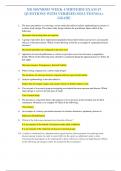 Popular
Popular
-
NR 503/NR503 WEEK 4 MIDTERM EXAM 67 QUESTIONS WITH VERIFIED SOLUTIONS/A+ GRADE
- Exam (elaborations) • 17 pages • 2023
-
- $15.79
- 14x sold
- + learn more
NR 503/NR503 WEEK 4 MIDTERM EXAM 67 QUESTIONS WITH VERIFIED SOLUTIONS/A+ GRADE 1. The nurse practitioner is reviewing a recent study that utilizes analytic epidemiology by means of a cohort study design. The cohort study design informs the practitioner about which of the following: Outcomes that develop from an exposure 2. A group of providers have implemented population-based intervention and are now assessing the efficacy of the intervention. Which of the following would be an exampl...
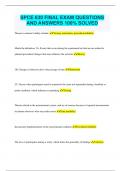 Popular
Popular
-
SPCE 630 FINAL EXAM QUESTIONS AND ANSWERS 100% SOLVED
- Exam (elaborations) • 14 pages • 2023 Popular
- Available in package deal
-
- $9.99
- 3x sold
- + learn more
SPCE 630 FINAL EXAM QUESTIONS AND ANSWERS 100% SOLVED Threats to internal validity include: Testing, maturation, procedural infidelity Match the definition. 2A. Events that occur during the experiment but that are not related to planned procedural changes that may influence the outcome History 2B. Changes in behavior due to the passage of time Maturation 2C. Occurs when participants need to respond to the same test repeatedly during a baseline or probe condition, which influences responding T...
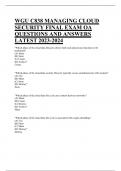
-
WGU C838 MANAGING CLOUD SECURITY FINAL EXAM OA QUESTIONS AND ANSWERS LATEST 2023-2024
- Exam (elaborations) • 36 pages • 2024
-
- $13.49
- 2x sold
- + learn more
"Which phase of the cloud data lifecycle allows both read and process functions to be performed? (A)Share (B)Store (C)Create (D)Archive" Create "Which phase of the cloud data security lifecycle typically occurs simultaneously with creation? (A)Use (B)Share (C)Store (D)Destroy" Store "Which phase of the cloud data life cycle uses content delivery networks? (A)Share (B)Create (C)Destroy (D)Archive" Share "Which phase of the cloud data life cycle is associated w...
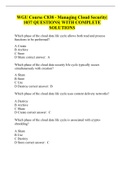
-
WGU Course C838 - Managing Cloud Security| 1037 QUESTIONS| WITH COMPLETE SOLUTIONS
- Exam (elaborations) • 209 pages • 2023
-
Available in package deal
-
- $15.99
- 3x sold
- + learn more
Which phase of the cloud data life cycle allows both read and process functions to be performed? A Create B Archive C Store D Share correct answer: A Which phase of the cloud data security life cycle typically occurs simultaneously with creation? A Share B Store C Use D Destroy correct answer: B Which phase of the cloud data life cycle uses content delivery networks? A Destroy B Archive C Share D Create correct answer: C Which phase of the cloud data life cycle is...
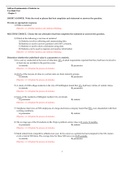
-
Test Bank for Fundamentals of Statistics, 6th edition by Michael Sullivan
- Exam (elaborations) • 350 pages • 2022
-
- $39.49
- 6x sold
- + learn more
Test Bank for Fundamentals of Statistics 6e 6th edition by Michael Sullivan. ISBN-13: 7022 Full Chapters test bank included 1. Data Collection 1.1 Introduction to the Practice of Statistics 1.2 Observational Studies versus Designed Experiments 1.3 Simple Random Sampling 1.4 Other Effective Sampling Methods 1.5 Bias in Sampling 1.6 The Design of Experiments Chapter 1 Review Chapter Test Making an Informed Decision: What College Should I Attend? II. DESCRIPTIVE STATISTICS 2....
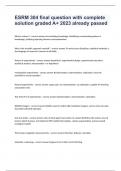
-
ESRM 304 final question with complete solution graded A+ 2023 already passed
- Exam (elaborations) • 14 pages • 2023
-
Available in package deal
-
- $19.99
- 1x sold
- + learn more
ESRM 304 final question with complete solution graded A+ 2023 already passed What is science? - correct answer Accumulating knowledge, identifying an interesting pattern in knowledge, justifying/rejecting theories and explanations Why is the scientific approach needed? - correct answer To work across disciplines; statistical methods is the language of research/ common in all fields Nature of experiments - correct answer Hypothesis, experimental design, experimental execution, statistical ...

-
NURS 328 Quiz 2| 230 Questions| With Complete Solutions
- Exam (elaborations) • 39 pages • 2023
-
Available in package deal
-
- $13.99
- 1x sold
- + learn more
research studies correct answer: often peer reviewed by two reviewers and are BLIND reviewed pre-experimental correct answer: A(n) __________design does not include mechanisms to compensate for the absence of either randomization or control group non-equivalent correct answer: This is a type of quasi-experimental design that involves a comparison group that was not developed on the basis of random assignment. It is called a _______________ control group design. Research studies in th...

-
CCRC Exam, ACRP CCRC EXAM PREP, CCRC Exam Prep, ACRP CCRC, *CCRC Study
- Exam (elaborations) • 226 pages • 2023
-
Available in package deal
-
- $15.59
- 2x sold
- + learn more
Clinical Trial - Answer- process of studying human subjects to assess the effect of a particular intervention (Drug, biologic, device, procedure or behavior change) on a pre specified set of measurable events. Endpoint or Outcome - Answer- Clinical event, measurable indicator, subject reported response Feasibility of a Study - Answer- Assessment of resource needs, regulator requirements, and potential level of risk of harm for human subjects participating in study Necessary controls in ...
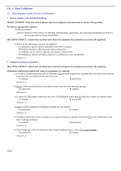
-
Test Bank for Statistics: Informed Decisions Using Data, 6th Edition by Michael Sullivan
- Exam (elaborations) • 502 pages • 2022
-
- $39.49
- 14x sold
- + learn more
Test Bank for Statistics: Informed Decisions Using Data 6e 6th Edition by Michael Sulliva. ISBN 0275, 6 Full chapters test bank PDF 1. Data Collection 1.1 Introduction to the Practice of Statistics 1.2 Observational Studies versus Designed Experiments 1.3 Simple Random Sampling 1.4 Other Effective Sampling Methods 1.5 Bias in Sampling 1.6 The Design of Experiments Chapter 1 Review Chapter Test Making an Informed Decision: What College Should I Attend? ...
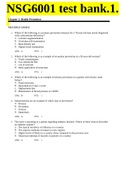
-
NSG6001 Test Bank.1.
- Exam (elaborations) • 157 pages • 2023
-
- $12.99
- 1x sold
- + learn more
NSG6001 Test Bank.1 Revised Questions and Correct Answers. Chapter 3. Health Promotion MULTIPLE CHOICE 1. Which of the following is a primary prevention measure for a 76-year-old man newly diagnosed with a testosterone deficiency? A. Calcium supplementation B. Testicular self-examination C. Bone density test D. Digital rectal examination ANS: A PTS: 1 2. Which of the following is an example of secondary prevention in a 50-year-old woman? A. Yearly mammogram B. Low animal-fat diet C....
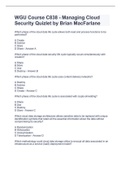
-
WGU Course C838 - Managing Cloud Security with complete solutions
- Exam (elaborations) • 148 pages • 2022
-
- $31.99
- 4x sold
- + learn more
Which phase of the cloud data life cycle allows both read and process functions to be performed? A Create B Archive C Store D Share A Which phase of the cloud data security life cycle typically occurs simultaneously with creation? A Share B Store C Use D Destroy B 00:57 01:12 Which phase of the cloud data life cycle uses content delivery networks? A Destroy B Archive C Share D Create C Which phase of the cloud data life cycle is associated with crypt...

How much did you already spend on Stuvia? Imagine there are plenty more of you out there paying for study notes, but this time YOU are the seller. Ka-ching! Discover all about earning on Stuvia


